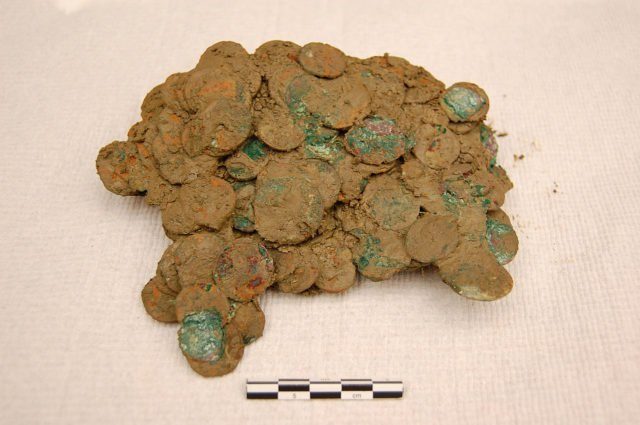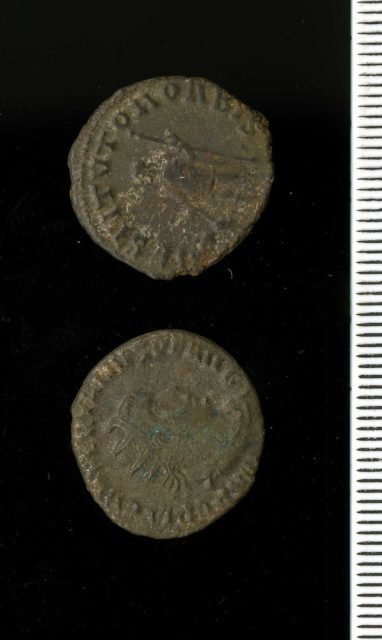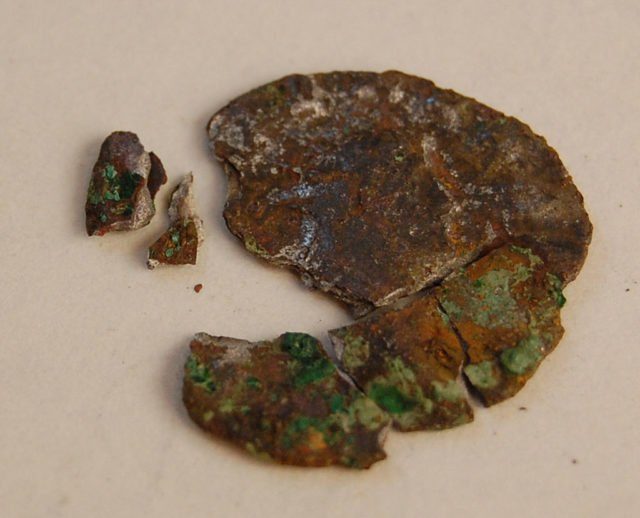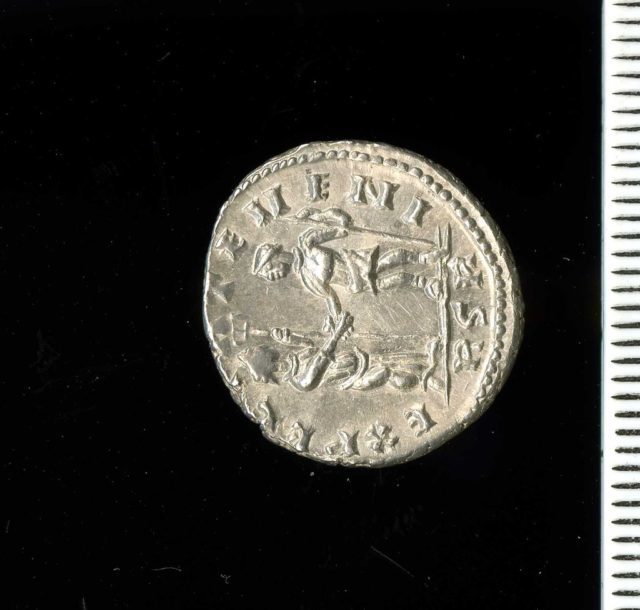The Frome Hoard is a cache of 52,503 silver and copper alloy Roman coins, found in April 2010 by chef and metal detector enthusiast Dave Crisp, near Frome in Somerset, England. The Frome Hoard is the most extensive coin stash uncovered in Britain so far.
It dates back to the reign of Carausius, a Roman military commander in the 3rd century who declared himself emperor of Britain. He reigned from 286 to 293 and was the first Roman to issue coins there. The Frome Hoard is the largest remaining group of the coins issued during the reign.

The hoard was discovered on April 11, 2010, while metal detectorist Dave Crisp was exploring a field near Frome where he had once before found Roman silver coins. The 62 late Roman period coins were most likely the remnants of a scattered hoard, 111 of which were discovered on the same farm in 1867. While searching for more coins, he detected an odd signal on his metal detector. As he dug the earth away, about 35 cm (14 inches) down, he discovered an ancient pot with a small coin resting on the lid. He realized his discovery could be an intact hoard and replaced the dirt in the small hole he had dug.
On April 15, 2010, Crisp notified Katie Hinds, Portable Antiquities Scheme Finds Liaison Officer for Wiltshire, of what he had found. On April 22, Hinds, Anna Booth, the Finds Liaison Officer for Somerset, and Alan Graham, an independent archaeologist contracted by Somerset County Council, returned to the field to complete an emergency excavation. The excavation took over three days, from April 23rd to the 25th, with Crisp showing the location of his discovery and Graham leading the dig. Hinds, Booth, and the landowner’s family helped with the project. Graham initially excavated a 1.5 meters (4.9 ft) trench around the small hole that Crisp had dug and identified the burial pit of the pot.

A small black-burnished bowl was inverted over the mouth of the pot, creating a lid. He excavated the earth around the exterior of the pot and spotted organic matter that may have been packing material.
He determined that the pot had been broken long before its discovery in 2010. The preferred archaeological method, which was usually moving the container to controlled conditions so that the contents could be correctly identified, would not work in this situation.

Because of the weight of the coins, the need to not draw general attention to the find, and the fragility of the pot and the coins inside it, the archaeologists decided to excavate the coins in the field. The coins were removed in 12 layers to determine if there was any chronological pattern in their positioning. Graham excavated and recorded the finds while the others packed the coins into 66 plastic bags with a total weight of about 160 kg (350 lb).
On April 26, the British Museum’s National Finds Advisor for Iron Age and Roman coins, Sam Moorhead, and the museum’s head of the Department of Portable Antiquities and Treasure, Roger Bland, collected the excavated coins and brought them back to London’s British Museum.
It was Metals Conservator Pippa Pearce’s job over the next six weeks to wash and dry all the coins to stabilize them, but she did not complete a full conservation due to the additional £35,000 in costs.

There were 52,503 coins found, but not all of these have been identified. 44,245 have been thoroughly examined, but the remaining coins are classified as illegible until cleaning and conservation are completed. Some of these will remain in their excavated state. Of the identifiable copper coins, 14,788 were minted by the central Roman Empire, 28,377 under the breakaway Gallic Empire, and 766, including five very rare silver denarii, under the Empire of Carausius.
Romans usually buried coins for security with the intention of eventually recovering them, but Sam Moorhead of the Portable Antiquities Scheme suggests that because the pot was large, fragile, and not recoverable without damage, the hoard may represent communal offerings to the gods.
A coroner’s treasure inquest held on July 22, 2010, determined the coins were the treasure and therefore property of the Crown. A museum can purchase these coins, but the 1996 Treasure Act sets out an officially agreed-upon price to be paid to both the finder and landowner. Somerset County’s Council Heritage Service expressed a desire to acquire the hoard for display at the new Museum of Somerset in Taunton for its re-opening in 2011. In October 2010, the treasure was valued at £320,250 by the Treasure Valuation Committee. A public appeal established to collect the money to enable the Museum of Somerset to purchase the coins prompted the Art Fund to bequeath an initial £40,250 to the fund.
The British Museum donated 50p for each copy sold of a book entitled The Frome Hoard, which was published by the Museum and written by Anna Booth, Roger Bland, and Sam Moorhead. Public donations were collected, and a grant from the National Heritage Memorial Fund (NHMF) rounded out the sum.

A selection of the coins was placed on display at the British Museum on July 8, 2010 at a press conference. The complete hoard was displayed in Gallery 68 of the British Museum between July 15 and August 31, 2010.
A few of the coins were exhibited at Frome Library on July 22, 2010, and again on October 23, 2010.
